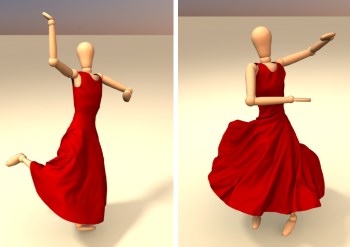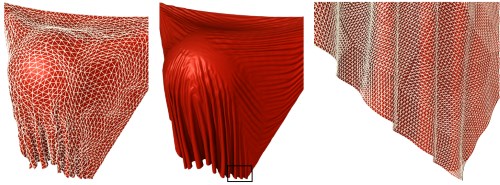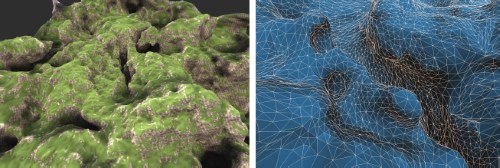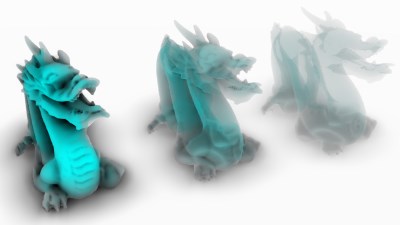Publications
Efficient GPU data structures and methods to solve sparse linear systems in dynamics applications

We present graphics processing unit (GPU) data structures and algorithms to efficiently solve sparse linear systems that are typically required in simulations of multi-body systems and deformable bodies. Thereby, we introduce an efficient sparse matrix data structure that can handle arbitrary sparsity patterns and outperforms current state-of-the-art implementations for sparse matrix vector multiplication. Moreover, an efficient method to construct global matrices on the GPU is presented where hundreds of thousands of individual element contributions are assembled in a few milliseconds. A finite-element-based method for the simulation of deformable solids as well as an impulse-based method for rigid bodies are introduced in order to demonstrate the advantages of the novel data structures and algorithms. These applications share the characteristic that a major computational effort consists of building and solving systems of linear equations in every time step. Our solving method results in a speed-up factor of up to 13 in comparison to other GPU methods.
» Show BibTeX
@article{WebBenSchStoFel13,
author = {Weber, Daniel and Bender, Jan and Schnoes, Markus and Stork, Andr{\'e} and Fellner, Dieter},
title = {Efficient {GPU} Data Structures and Methods to Solve Sparse Linear Systems in Dynamics Applications},
year = {2013},
journal = {Computer Graphics Forum},
volume = {32},
number = {1},
publisher = {Blackwell Publishing Ltd},
issn = {1467-8659},
url = {http://dx.doi.org/10.1111/j.1467-8659.2012.03227.x},
doi = {10.1111/j.1467-8659.2012.03227.x},
pages = {16--26},
}
Position-based Methods for the Simulation of Solid Objects in Computer Graphics

The dynamic simulation of solids has a long history in computer graphics. The classical methods in this field are based on the use of forces or impulses to simulate joints between rigid bodies as well as the stretching, shearing and bending stiffness of deformable objects. In the last years the class of position-based methods has become popular in the graphics community. These kinds of methods are fast, unconditionally stable and controllable which make them well-suited for the use in interactive environments. Position-based methods are not as accurate as force based methods in general but they provide visual plausibility. Therefore, the main application areas of these approaches are virtual reality, computer games and special effects in movies.
This state of the art report covers the large variety of position-based methods that were developed in the field of deformable solids. We will introduce the concept of position-based dynamics, present dynamic simulation based on shape matching and discuss data-driven approaches. Furthermore, we will present several applications for these methods.
@inproceedings{BMOT2013,
title = "Position-based Methods for the Simulation of Solid Objects in Computer Graphics",
author = "Jan Bender and Matthias M{\"u}ller and Miguel A. Otaduy and Matthias Teschner",
year = "2013",
booktitle = "EUROGRAPHICS 2013 State of the Art Reports",
publisher = "Eurographics Association",
location = "Girona, Spain"
}
Fast and stable cloth simulation based on multi-resolution shape matching

We present an efficient and unconditionally stable method which allows the deformation of very complex stiff cloth models in real-time. This method is based on a shape matching approach which uses edges and triangles as 1D and 2D regions to simulate stretching and shearing resistance. Previous shape matching approaches require large overlapping regions to simulate stiff materials. This unfortunately also affects the bending behavior of the model. Instead of using large regions, we introduce a novel multi-resolution shape matching approach to increase only the stretching and shearing stiffness. Shape matching is performed for each level of the multi-resolution model and the results are propagated from one level to the next one. To preserve the fine wrinkles of the cloth on coarse levels of the hierarchy we present a modified version of the original shape matching method. The introduced method for cloth simulation can perform simulations in linear time and has no numerical damping. Furthermore, we show that multi-resolution shape matching can be performed efficiently on the GPU.
» Show BibTeX
@ARTICLE{Bender2013_2,
author = {Jan Bender and Daniel Weber and Raphael Diziol},
title = {Fast and stable cloth simulation based on multi-resolution shape matching},
journal = {Computers \& Graphics },
year = {2013},
volume = {37},
pages = {945 - 954},
number = {8},
doi = {http://dx.doi.org/10.1016/j.cag.2013.08.003},
issn = {0097-8493},
url = {http://www.sciencedirect.com/science/article/pii/S0097849313001283}
}
Adaptive cloth simulation using corotational finite elements

In this article we introduce an efficient adaptive cloth simulation method which is based on a reversible $\sqrt{3}$-refinement of corotational finite elements. Our novel approach can handle arbitrary triangle meshes and is not restricted to regular grid meshes which are required by other adaptive methods. Most previous works in the area of adaptive cloth simulation use discrete cloth models like mass-spring systems in combination with a specific subdivision scheme. However, if discrete models are used, the simulation does not converge to the correct solution as the mesh is refined. Therefore, we introduce a cloth model which is based on continuum mechanics since continuous models do not have this problem. We use a linear elasticity model in combination with a corotational formulation to achieve a high performance. Furthermore, we present an efficient method to update the sparse matrix structure after a refinement or coarsening step. The advantage of the $\sqrt{3}$-subdivision scheme is that it generates high quality meshes while the number of triangles increases only by a factor of 3 in each refinement step. However, the original scheme was not intended for the use in an interactive simulation and only defines a mesh refinement. In this article we introduce a combination of the original refinement scheme with a novel coarsening method to realize an adaptive cloth simulation with high quality meshes. The proposed approach allows an efficient mesh adaption and therefore does not cause much overhead. We demonstrate the significant performance gain which can be achieved with our adaptive simulation method in several experiments including a complex garment simulation.
» Show BibTeX
@ARTICLE{Bender2013,
author = {Jan Bender and Crispin Deul},
title = {Adaptive cloth simulation using corotational finite elements },
journal = {Computers \& Graphics },
year = {2013},
volume = {37},
pages = {820 - 829},
number = {7},
doi = {http://dx.doi.org/10.1016/j.cag.2013.04.008},
url = {http://www.sciencedirect.com/science/article/pii/S0097849313000605},
issn = {0097-8493}
}
Physically-Based Character Skinning

In this paper we present a novel multi-layer model for physically-based character skinning. In contrast to geometric approaches which are commonly used in the field of character skinning, physically-based methods can simulate secondary motion effects. Furthermore, these methods can handle collisions and preserve the volume of the model without the need of an additional post-process. Physically-based approaches are computationally more expensive than geometric methods but they provide more realistic results. Recent works in this area use finite element simulations to model the elastic behavior of skin. These methods require the generation of a volumetric mesh for the skin shape in a pre-processing step. It is not easy for an artist to model the different elastic behaviors of muscles, fat and skin using a volumetric mesh since there is no clear assignment between volume elements and tissue types. For our novel multi-layer model the mesh generation is very simple and can be performed automatically. Furthermore, the model contains a layer for each kind of tissue. Therefore, the artist can easily control the elastic behavior by adjusting the stiffness parameters for muscles, fat and skin. We use shape matching with oriented particles and a fast summation technique to simulate the elastic behavior of our skin model and a position-based constraint enforcement to handle collisions, volume conservation and the coupling of the skeleton with the deformable model. Position-based methods have the advantage that they are fast, unconditionally stable, controllable and provide visually plausible results.
» Show BibTeX
@inproceedings{Deul2013,
author = {Crispin Deul and Jan Bender},
title = {Physically-Based Character Skinning},
booktitle = {Virtual Reality Interactions and Physical Simulations (VRIPhys)},
year = {2013},
month = nov,
address = {Lille, France},
publisher = {Eurographics Association}
}
Multilevel Cloth Simulation using GPU Surface Sampling

Today most cloth simulation systems use triangular mesh models. However, regular grids allow many optimizations as connectivity is implicit, warp and weft directions of the cloth are aligned to grid edges and distances between particles are equal. In this paper we introduce a cloth simulation that combines both model types. All operations that are performed on the CPU use a low-resolution triangle mesh while GPU-based methods are performed efficiently on a high-resolution grid representation. Both models are coupled by a sampling operation which renders triangle vertex data into a texture and by a corresponding projection of texel data onto a mesh. The presented scheme is very flexible and allows individual components to be performed on different architectures, data representations and detail levels. The results are combined using shader programs which causes a negligible overhead. We have implemented CPU-based collision handling and a GPU-based hierarchical constraint solver to simulate systems with more than 230k particles in real-time.
» Show BibTeX
@inproceedings{Schmitt2013,
author = {Nikolas Schmitt and Martin Knuth and Jan Bender and Arjan Kuijper},
title = {Multilevel Cloth Simulation using GPU Surface Sampling},
booktitle = {Virtual Reality Interactions and Physical Simulations (VRIPhys)},
year = {2013},
month = nov,
address = {Lille, France},
publisher = {Eurographics Association}
}
Level of Detail for Real-Time Volumetric Terrain Rendering

Terrain rendering is an important component of many GIS applications and simulators. Most methods rely on heightmap-based terrain which is simple to acquire and handle, but has limited capabilities for modeling features like caves, steep cliffs, or overhangs. In contrast, volumetric terrain models, e.g. based on isosurfaces can represent arbitrary topology. In this paper, we present a fast, practical and GPU-friendly level of detail algorithm for large scale volumetric terrain that is specifically designed for real-time rendering applications. Our algorithm is based on a longest edge bisection (LEB) scheme. The resulting tetrahedral cells are subdivided into four hexahedra, which form the domain for a subsequent isosurface extraction step. The algorithm can be used with arbitrary volumetric models such as signed distance fields, which can be generated from triangle meshes or discrete volume data sets. In contrast to previous methods our algorithm does not require any stitching between detail levels. It generates crack free surfaces with a good triangle quality. Furthermore, we efficiently extract the geometry at runtime and require no preprocessing, which allows us to render infinite procedural content with low memory consumption.
» Show BibTeX
@inproceedings{Scholz2013,
author = {Manuel Scholz and Jan Bender and Carsten Dachsbacher },
title = {{Level of Detail for Real-Time Volumetric Terrain Rendering}},
pages = {211-218},
URL = {http://diglib.eg.org/EG/DL/PE/VMV/VMV13/211-218.pdf},
DOI = {10.2312/PE.VMV.VMV13.211-218},
editor = {Michael Bronstein and Jean Favre and Kai Hormann},
booktitle = {VMV 2013: Vision, Modeling & Visualization},
year = {2013},
address = {Lugano, Switzerland},
publisher = {Eurographics Association}
}
Screen-Space Ambient Occlusion Using A-buffer Techniques

Computing ambient occlusion in screen-space (SSAO) is a common technique in real-time rendering applications which use rasterization to process 3D triangle data. However, one of the most critical problems emerging in screen-space is the lack of information regarding occluded geometry which does not pass the depth test and is therefore not resident in the G-buffer. These occluded fragments may have an impact on the proximity-based shadowing outcome of the ambient occlusion pass. This not only decreases image quality but also prevents the application of SSAO on multiple layers of transparent surfaces where the shadow contribution depends on opacity. We propose a novel approach to the SSAO concept by taking advantage of per-pixel fragment lists to store multiple geometric layers of the scene in the G-buffer, thus allowing order independent transparency (OIT) in combination with high quality, opacity-based ambient occlusion (OITAO). This A-buffer concept is also used to enhance overall ambient occlusion quality by providing stable results for low-frequency details in dynamic scenes. Furthermore, a flexible compression-based optimization strategy is introduced to improve performance while maintaining high quality results.
» Show BibTeX
@inproceedings{Bauer2013,
author = {Fabian Bauer and Martin Knuth and Jan Bender},
title = {Screen-Space Ambient Occlusion Using A-buffer Techniques},
booktitle = {International Conference on Computer-Aided Design and Computer Graphics},
year = {2013},
month = nov,
address = {Hong Kong, China},
publisher = {IEEE}
}
Previous Year (2012)

